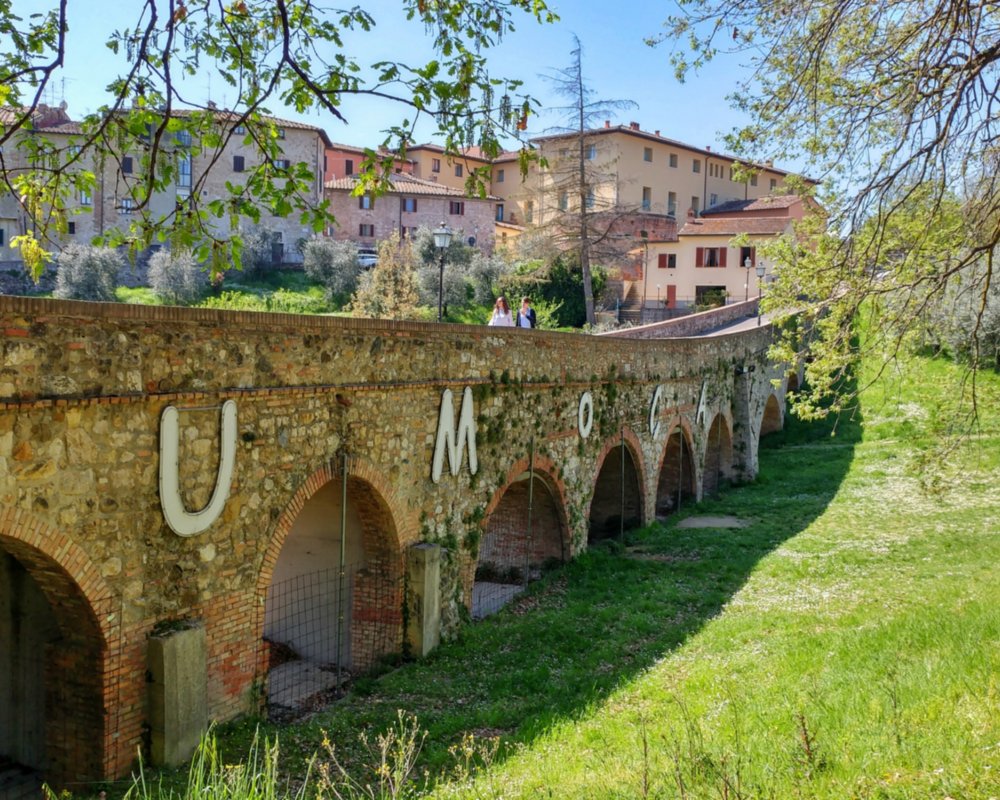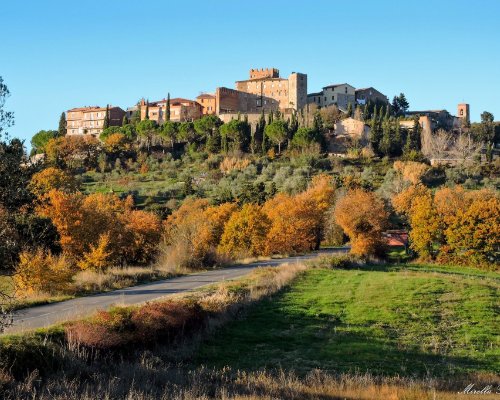Vacations in the Siena area, amidst Renaissance beauties and well-being
If you’re familiar with Tuscany, then you surely know how fascinating the Siena area is: a mix of beauty, history and nature. The most renowned figures in history have passed through these parts, and contemporary artists continue to come here in search of inspiration.
Two free days are the perfect opportunity to visit the “lesser-known” villages in the territory, particularly exploring the best of the Val di Merse and the Val d’Elsa. The time-based tour we’re proposing starts in Colle Val d’Elsa, a gem of a city where culture blends with tradition; the journey continues to Radicondoli, a medieval city that overlooks the Metalliferous Hills on the way to the sea; Montinciano (with the chance to visit the Petriolo hot springs); and Murlo, the village/castle dating to the Etruscan era.
The Val d’Elsa is located north-west of Siena. From the major medieval city, you can reach it by traveling the via Cassia all the way to Poggibonsi, arriving in Colle Val d’Elsa, a splendid town with elegant medieval and Renaissance architecture.
From Colle, you can head down to Casole d’Elsa, where the main museum houses a series of highly valuable artworks: a painting of the Madonna and Child with Saints commissioned in 1498 by the Agostani family to Andrea di Niccolò, a Visitation by Girolamo del Pacchia (c. 1520) and, made that same year, a fresco by Pacciarotto depicting the Madonna and Child with Saints Donatus, Michael the Archangel, Sebastian and Nicholas, taken from Palazzo Pretorio.
Following the same road, you’ll arrive in Radicondoli, in the heart of the valley. Here, you’ll find the Convent of Santa Caterina, where Pietro Orioli painted an Assumption and the Nativity beneath. The work, painted in the 1490s and now on display in the Collegiate Church of Santi Simone e Guida, is one of the artist’s best late-life works.
Another stop in the Val d’Elsa could be San Gimignano, where in the Chapel of Santa Fina you’ll find a magnificent fresco cycle by Ghirlandaio and his close collaborators; or Staggia, home to an altar painted by Antonio del Pollaiolo; or even the splendid and isolated Abbadia a Isola, where the Church of San Cirino boasts the an altarpiece decorated by Sano di Pietro.
The Val d’Elsa is located north-west of Siena. From the major medieval city, you can reach it by traveling the via Cassia all the way to Poggibonsi, arriving in Colle Val d’Elsa, a splendid town with elegant medieval and Renaissance architecture.
From Colle, you can head down to Casole d’Elsa, where the main museum houses a series of highly valuable artworks: a painting of the Madonna and Child with Saints commissioned in 1498 by the Agostani family to Andrea di Niccolò, a Visitation by Girolamo del Pacchia (c. 1520) and, made that same year, a fresco by Pacciarotto depicting the Madonna and Child with Saints Donatus, Michael the Archangel, Sebastian and Nicholas, taken from Palazzo Pretorio.
Following the same road, you’ll arrive in Radicondoli, in the heart of the valley. Here, you’ll find the Convent of Santa Caterina, where Pietro Orioli painted an Assumption and the Nativity beneath. The work, painted in the 1490s and now on display in the Collegiate Church of Santi Simone e Guida, is one of the artist’s best late-life works.
Another stop in the Val d’Elsa could be San Gimignano, where in the Chapel of Santa Fina you’ll find a magnificent fresco cycle by Ghirlandaio and his close collaborators; or Staggia, home to an altar painted by Antonio del Pollaiolo; or even the splendid and isolated Abbadia a Isola, where the Church of San Cirino boasts the an altarpiece decorated by Sano di Pietro.
The second day continues in the nearby Val di Merse, the wildest land in the Siena area. And yet, surrounded by unspoilt forests, you can find masterpieces of Renaissance art, like the Church of San Giovanni Battista in Rosia, with an altarpiece by Matteo di Giovanni’s greatest disciple, Guidoccio Cozzarelli, depicting a Madonna and Child Enthroned with Saints Sebastian and Anthony the Abbot.
Travelling the roads that wind through the forests, you’ll come to Monticiano and the nearby Petriolo hot springs. The latter is a thermal resort used since the Middle Ages for the presence of sulphur-rich waters with curative properties. The hot springs have been visited by many famous figures, including members of the Medici and Gonzaga families, cardinals, dukes and the excellent regular, Pope Pius II – Enea Silvio Piccolomini.
If you want to surround yourself with Renaissance elements after Petriolo, just head north to Murlo. Here, in the second half of the 1500s, the churches were decorated and renovated: the Parish Church of San Fortunato in Vescovado still conserves its large altarpiece, a triptych by Benvenuto di Giovanni, signed and dated 1475, depicting the Madonna and Child Enthroned, Angels Playing Music and Saints Catherine of Alexandria, Michael the Archangel, Blaise and Lucy; above is Christ Blessing with Saints Ansanus and Lawrence. The work boasts exceptional formal elegance, the use of new perspectives influenced by Vecchietta in full effect. In the same church, there’s also a surviving panel of a polyptych, today dispersed around the world, by Andrea di Niccolò, painted for the parish church in Carli and which only the Madonna and Child remains in Italy, the central part of a triptych whose side panels with saints are now in international museums.
The second day continues in the nearby Val di Merse, the wildest land in the Siena area. And yet, surrounded by unspoilt forests, you can find masterpieces of Renaissance art, like the Church of San Giovanni Battista in Rosia, with an altarpiece by Matteo di Giovanni’s greatest disciple, Guidoccio Cozzarelli, depicting a Madonna and Child Enthroned with Saints Sebastian and Anthony the Abbot.
Travelling the roads that wind through the forests, you’ll come to Monticiano and the nearby Petriolo hot springs. The latter is a thermal resort used since the Middle Ages for the presence of sulphur-rich waters with curative properties. The hot springs have been visited by many famous figures, including members of the Medici and Gonzaga families, cardinals, dukes and the excellent regular, Pope Pius II – Enea Silvio Piccolomini.
If you want to surround yourself with Renaissance elements after Petriolo, just head north to Murlo. Here, in the second half of the 1500s, the churches were decorated and renovated: the Parish Church of San Fortunato in Vescovado still conserves its large altarpiece, a triptych by Benvenuto di Giovanni, signed and dated 1475, depicting the Madonna and Child Enthroned, Angels Playing Music and Saints Catherine of Alexandria, Michael the Archangel, Blaise and Lucy; above is Christ Blessing with Saints Ansanus and Lawrence. The work boasts exceptional formal elegance, the use of new perspectives influenced by Vecchietta in full effect. In the same church, there’s also a surviving panel of a polyptych, today dispersed around the world, by Andrea di Niccolò, painted for the parish church in Carli and which only the Madonna and Child remains in Italy, the central part of a triptych whose side panels with saints are now in international museums.

